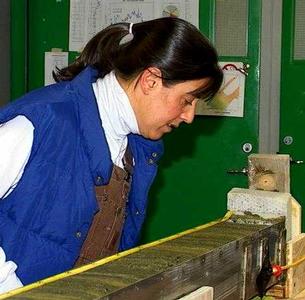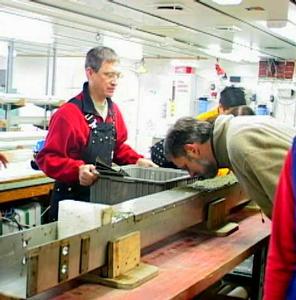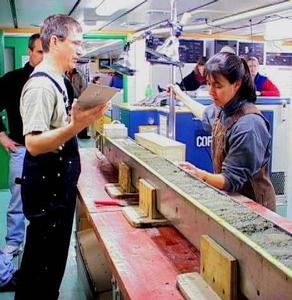
|
|
18 February, 2001
In the Lab
Many things happen on station besides bringing the cores on deck. Once
the sediment is inside the lab it is as though you were in an emergency
room. Time is critical: some samples must to be collected as soon as
possible, whereas others can wait until later. You can work a whole shift
without stopping except to eat, and even then we have to hurry back. One
of the most labor intensive activities is processing the Kasten core. Once
it is on board and brought into the lab we use screwdrivers to open up the
metal plates on top. You can tell when they have opened a Kasten by the
smell! Here is a picture of Dr. Dunbar smelling the sediment, but you don't
need to get that close. The smell is from hydrogen sulfide, which is
released from the core due to the decrease in pressure between the ocean
floor and the water surface. Look for the picture where our lead
scientist, Amy Leventer, is looking at the inside of the core, what do you
see? If you are a good observer what you should notice that the sediment
is layered. The layers are called laminations and represent differences in
the environment over time. One of the things that we look for from the sea
floor soundings (Bathy 2000) is not only if sediment is present, but also
what kind of sediment it is. The kind that we are looking for is called
"diatomaceous ooze". After the Kasten core has been opened, we scrape off
the top layer of sediment that was in contact with the metal plates.
Usually, as the core barrel is pushed through the sediment, the outside
layer gets a little "smeared", making it hard to see the layers.
Painstakingly, we then describe the core, using special, symbolized
drawings to represent different kinds of sediment and laminations.
Photographs of the sediment are carefully taken for reference at a future
date. After that, it's a real team effort; everyone needs sediment samples
for different research. Small bags and bottles of sediment are collected
from regular intervals or specific depths, depending on the layering.
Slides are also made to look at the sediment under the microscope. By the
time everyone has taken his or her samples a whole, 12 hour shift may have
passed. There is very little sediment left in the Kasten core at the end!




Contact the TEA in the field at
.
If you cannot connect through your browser, copy the
TEA's e-mail address in the "To:" line of
your favorite e-mail package.
|
